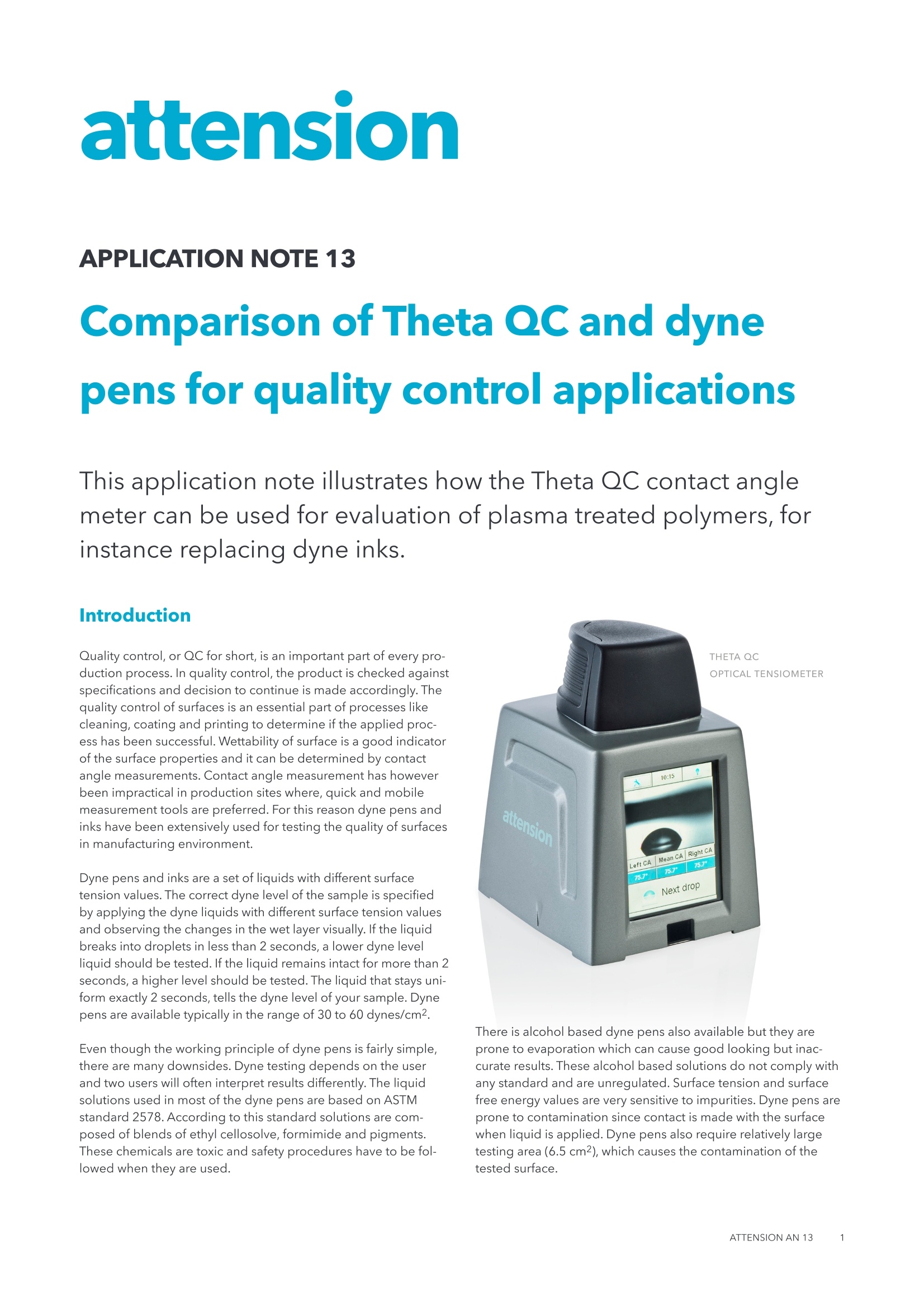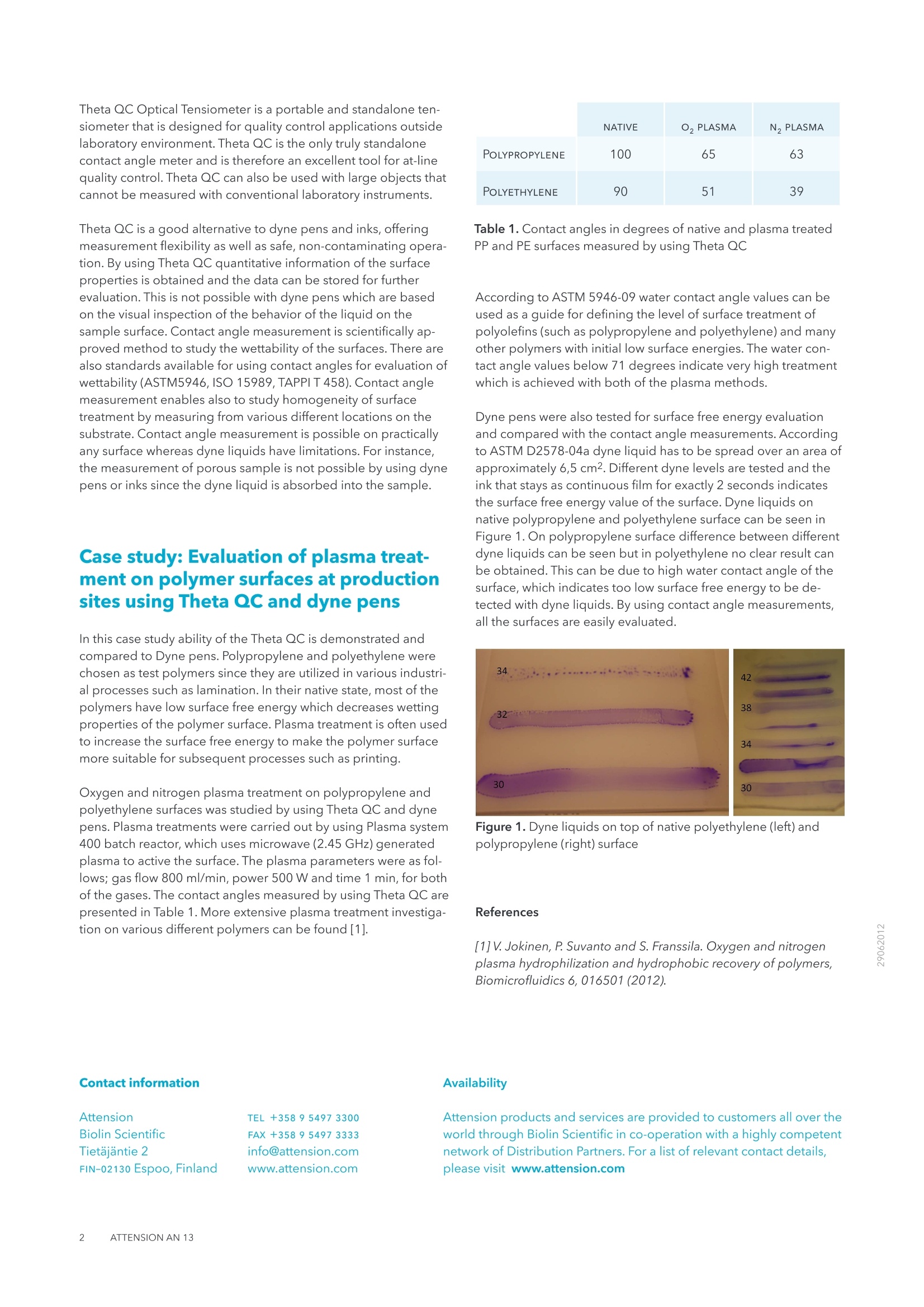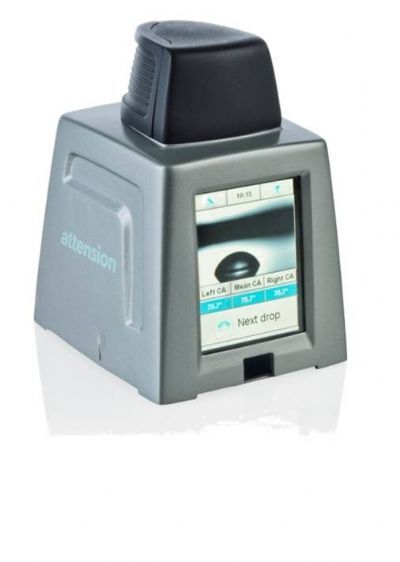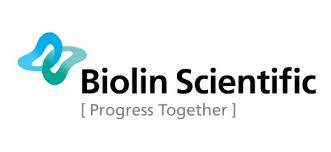方案详情
文
本应用具体说明了Attension Theta QC接触角测量仪代替达因墨在等离子体处理聚合物评价中的应用。
方案详情

ATTENSION AN 13 attension APPLICATION NOTE 13 This application note illustrates how the Theta QC contact anglemeter can be used for evaluation of plasma treated polymers, forinstance replacing dyne inks. Introduction Quality control, or QC for short, is an important part of every pro-duction process. In quality control, the product is checked againstspecifications and decision to continue is made accordingly. Thequality control of surfaces is an essential part of processes likecleaning, coating and printing to determine if the applied proc-ess has been successful. Wettability of surface is a good indicatorof the surface properties and it can be determined by contactangle measurements. Contact angle measurement has howeverbeen impractical in production sites where, quick and mobilemeasurement tools are preferred.For this reason dyne pens andinks have been extensively used for testing the quality of surfacesin manufacturing environment. Dyne pens and inks are a set of liquids with different surfacetension values. The correct dyne level of the sample is specifiedby applying the dyne liquids with different surface tension valuesand observing the changes in the wet layer visually. If the liquidbreaks into droplets in less than 2 seconds, a lower dyne levelliquid should be tested. If the liquid remains intact for more than 2seconds, a higher level should be tested. The liquid that stays uni-form exactly 2 seconds, tells the dyne level of your sample. Dynepens are available typically in the range of 30 to 60 dynes/cm2. Even though the working principle of dyne pens is fairly simple,there are many downsides. Dyne testing depends on the userand two users will often interpret results differently. The liquidsolutions used in most of the dyne pens are based on ASTMstandard 2578. According to this standard solutions are com-posed of blends of ethyl cellosolve, formimide and pigments.These chemicals are toxic and safety procedures have to be fol-lowed when they are used. There is alcohol based dyne pens also available but they areprone to evaporation which can cause good looking but inac-curate results. These alcohol based solutions do not comply withany standard and are unregulated. Surface tension and surfacefree energy values are very sensitive to impurities. Dyne pens areprone to contamination since contact is made with the surfacewhen liquid is applied. Dyne pens also require relatively largetesting area (6.5 cm2), which causes the contamination of thetested surface. Theta QC Optical Tensiometer is a portable and standalone ten-siometer that is designed for quality control applications outsidelaboratory environment. Theta QC is the only truly standalonecontact angle meter and is therefore an excellent tool for at-linequality control. Theta QC can also be used with large objects thatcannot be measured with conventional laboratory instruments. Theta QC is a good alternative to dyne pens and inks, offeringmeasurement flexibility as well as safe, non-contaminating opera-tion. By using Theta QC quantitative information of the surfaceproperties is obtained and the data can be stored for furtherevaluation. This is not possible with dyne pens which are basedon the visual inspection of the behavior of the liquid on thesample surface. Contact angle measurement is scientifically ap-proved method to study the wettability of the surfaces. There arealso standards available for using contact angles for evaluation ofwettability (ASTM5946, ISO 15989,TAPPIT458). Contact anglemeasurement enables also to study homogeneity of surfacetreatment by measuring from various different locations on thesubstrate. Contact angle measurement is possible on practicallyany surface whereas dyne liquids have limitations. For instance,the measurement of porous sample is not possible by using dynepens or inks since the dyne liquid is absorbed into the sample. In this case study ability of the Theta QC is demonstrated andcompared to Dyne pens. Polypropylene and polyethylene werechosen as test polymers since they are utilized in various industri-al processes such as lamination. In their native state, most of thepolymers have low surface free energy which decreases wettingproperties of the polymer surface. Plasma treatment is often usedto increase the surface free energy to make the polymer surfacemore suitable for subsequent processes such as printing. Oxygen and nitrogen plasma treatment on polypropylene andpolyethylene surfaces was studied by using Theta QC and dynepens. Plasma treatments were carried out by using Plasma system400 batch reactor, which uses microwave (2.45 GHz) generatedplasma to active the surface. The plasma parameters were as fol-lows; gas flow 800 ml/min, power 500 W and time 1 min, for bothof the gases. The contact angles measured by using Theta QC arepresented in Table 1. More extensive plasma treatment investiga-tion on various different polymers can be found [1]. Contact information AttensionBiolin ScientificTietajantie 2FIN-02130 Espoo,Finland NATIVE O,PLASMA N2 PLASMA POLYPROPYLENE 100 65 63 POLYETHYLENE 90 51 39 Table 1. Contact angles in degrees of native and plasma treatedPP and PE surfaces measured by using Theta QC According to ASTM 5946-09 water contact angle values can beused as a guide for defining the level of surface treatment ofpolyolefins (such as polypropylene and polyethylene) and manyother polymers with initial low surface energies. The water con-tact angle values below 71 degrees indicate very high treatmentwhich is achieved with both of the plasma methods. Dyne pens were also tested for surface free energy evaluationand compared with the contact angle measurements. Accordingto ASTM D2578-04a dyne liquid has to be spread over an area ofapproximately 6,5 cm2. Different dyne levels are tested and theink that stays as continuous film for exactly 2 seconds indicatesthe surface free energy value of the surface. Dyneliquids onnative polypropylene and polyethylene surface can be seen inFigure 1. On polypropylene surface difference between differentdyne liquids can be seen but in polyethylene no clear result canbe obtained. This can be due to high water contact angle of thesurface, which indicates too low surface free energy to be de-tected with dyne liquids. By using contact angle measurements,all the surfaces are easily evaluated. Figure 1. Dyne liquids on top of native polyethylene (left) andpolypropylene (right) surface References [1]V. Jokinen, P. Suvanto and S. Franssila. Oxygen and nitrogenplasma hydrophilization and hydrophobic recovery of polymers,Biomicrofluidics 6,016501 (2012). Availability
确定


还剩1页未读,是否继续阅读?
瑞典百欧林科技有限公司为您提供《Theta QC 与达因笔在质量检测应用中的比较》,该方案主要用于其他中--检测,参考标准--,《Theta QC 与达因笔在质量检测应用中的比较》用到的仪器有Theta QC 光学接触角仪
相关方案
更多
该厂商其他方案
更多










